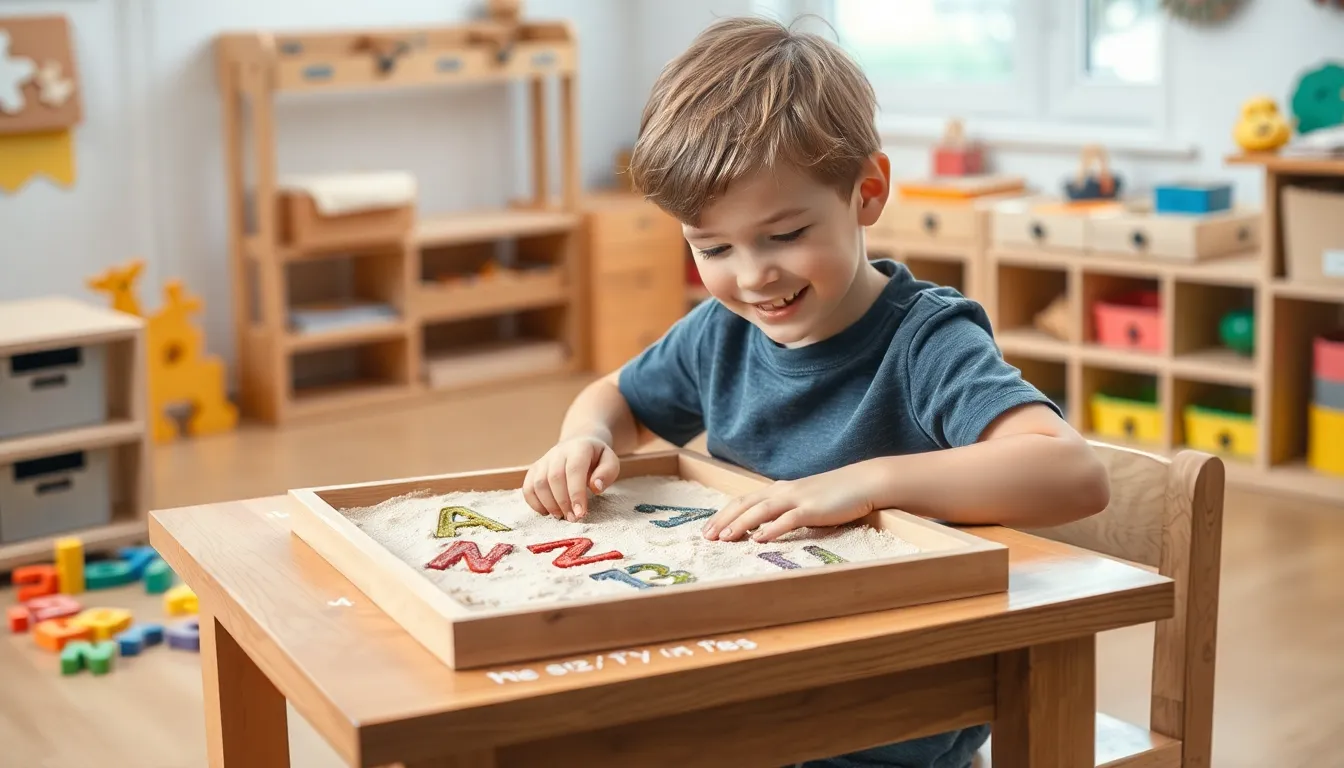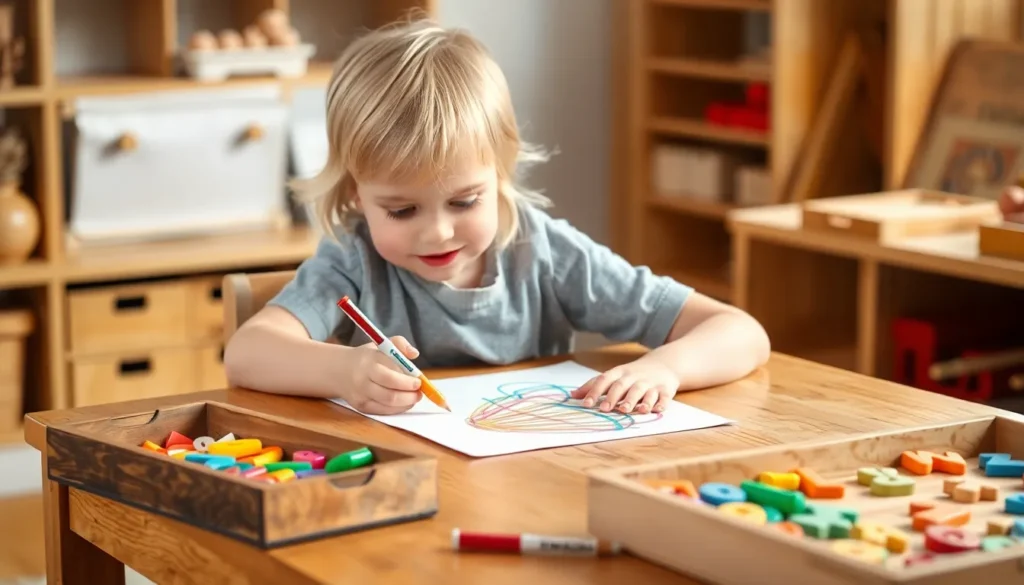Table of Contents
ToggleIn the world of early childhood education, Montessori writing activities stand out as a unique approach that fosters creativity and independence. By engaging children in hands-on experiences, these activities cultivate a love for writing while enhancing fine motor skills. The Montessori method emphasizes learning through exploration, allowing young learners to express themselves freely.
These activities not only make writing enjoyable but also align with the natural development of children. Through the use of specially designed materials, kids can discover letters, sounds, and words at their own pace. This individualized learning process nurtures confidence and encourages a lifelong passion for literacy. With the right Montessori writing activities, parents and educators can create an enriching environment that supports each child’s unique journey in writing.
Overview of Montessori Writing Activities
Montessori writing activities encompass a variety of hands-on techniques designed to engage young learners in the writing process. These activities focus on developing fine motor skills, letter recognition, and phonemic awareness, which are crucial for early writing development. Materials used in these activities often include sandpaper letters, writing trays, and movable alphabets that promote tactile exploration.
Children in a Montessori setting benefit from individualized learning experiences. They explore writing at their own pace, selecting activities that interest them most. Examples of common writing activities include tracing letters in sand, creating words with letter tiles, and journaling in individualized notebooks.
Writing activities foster creativity and self-expression, allowing children to convey their thoughts and ideas through written words. Using tools like colorful markers and various writing surfaces inspires artistic expression and motivation. Educators and parents play a vital role by creating an environment that encourages exploration, ensuring children feel supported in their writing journey.
Additional benefits of Montessori writing activities include enhancing language skills and building confidence. As children engage with letters and words, they develop an understanding of language structure and usage. This foundational knowledge empowers learners to explore literacy with enthusiasm and curiosity, establishing a lifelong love for writing.
Importance of Montessori Writing Activities

Montessori writing activities play a crucial role in early childhood education, significantly contributing to children’s overall development. They foster essential skills while promoting a positive attitude towards writing.
Enhancing Motor Skills
Montessori writing activities enhance fine motor skills through engaging, hands-on experiences. Activities like tracing letters in sand or manipulating movable alphabets require precise hand movements, strengthening hand-eye coordination. Utilizing tools, such as writing trays and varied writing instruments, encourages grip and control, helping children develop the dexterity needed for writing. Research indicates that fine motor skill development directly correlates with later academic success, particularly in literacy (Berk, 2018).
Fostering Independence
Montessori writing activities foster independence by allowing children to choose their writing experiences. This freedom encourages self-directed exploration, enabling children to pursue their interests at a comfortable pace. Engaging in personalized activities, such as journaling or creating stories, empowers children to express their thoughts and feelings, cultivating confidence. As they navigate their writing journeys, children develop critical problem-solving skills and resilience, essential for overall growth and development.
Types of Montessori Writing Activities
Montessori writing activities include various hands-on techniques designed to engage children and develop their writing skills. These activities promote fine motor development and creativity, providing children with opportunities to learn through exploration.
Sandpaper Letters
Sandpaper letters are textured materials that help children learn letter shapes through tactile experience. These letters are typically made from sandpaper attached to wooden shapes. Children trace the letters with their fingers, reinforcing their understanding of letter formation while developing hand-eye coordination. This activity encourages sensory engagement, making the learning process memorable. Children can also practice phonics by associating sounds with each letter, enhancing both their writing and language skills.
Moveable Alphabet
The moveable alphabet consists of individual letters that children can manipulate to form words. This tactile resource supports phonemic awareness, allowing children to experiment with spelling and sentence construction. By rearranging letters, they create words visually, which reinforces their understanding of language structure. This activity fosters creativity by encouraging children to express their thoughts and ideas through writing, encouraging self-directed exploration and independent learning.
Writing with Natural Materials
Writing with natural materials integrates creativity and environmental awareness into writing activities. Children use items like twigs, leaves, or stones as writing tools on surfaces such as sand, dirt, or bark. This approach enhances sensory exploration and connects children to nature, stimulating both their imaginative and fine motor skills. Children can also use natural materials to create letters and words, providing a unique way to learn while enjoying the outdoors. These experiences instill a love for writing through innovative and playful methods.
Tips for Implementing Montessori Writing Activities at Home
Implementing Montessori writing activities at home requires intentionality in creating an environment that nurtures children’s independence and creativity. These practices can significantly enhance a child’s writing skills.
Creating a Prepared Environment
Creating a prepared environment fosters exploration and enhances children’s writing experiences. Organize writing materials, such as colored pencils, chalk, and crayons, within easy reach. Provide various writing surfaces, including unlined paper, chalkboards, or writing trays filled with sand or flour for tactile practice. Arrange materials by type and encourage children to select tools based on their interests. Include a quiet, designated writing area equipped with comfortable seating and proper lighting. Display alphabet charts and writing prompts nearby to inspire creativity and focus.
Encouraging Self-Correction
Encouraging self-correction develops children’s confidence and independence in writing. Provide tools like self-checklists and visual guides that outline writing expectations. Encourage children to review their work critically, allowing them to identify errors independently. Promote the use of plain paper or lined journals, giving them the freedom to rewrite as needed. When children make mistakes, note their thought process and celebrate the corrections. This approach fosters a growth mindset, reinforcing the idea that writing is a process of continuous learning and improvement.
Montessori writing activities play a vital role in shaping young learners’ writing journeys. By fostering creativity independence and fine motor skills these activities create a rich environment for exploration. Children engage in meaningful experiences that not only enhance their writing abilities but also build confidence and a love for literacy.
As they navigate these activities they develop essential skills that extend beyond writing. The emphasis on self-directed learning encourages problem-solving resilience and a positive attitude towards challenges. Parents and educators can support this growth by providing a prepared environment that inspires curiosity and creativity.
Ultimately the integration of Montessori writing activities lays a strong foundation for lifelong learning and self-expression.





